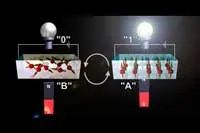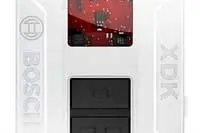Electronics News
Archive : 4 July 2016 год
 Scientists at Hokkaido University have developed a device that employs both magnetic and electronic signals, which could provide twice the storage capacity of conventional memory devices, such as USB flash drives.
Scientists at Hokkaido University have developed a device that employs both magnetic and electronic signals, which could provide twice the storage capacity of conventional memory devices, such as USB flash drives.
The team at Hokkaido University's Research Institute for Electronic Science investigated the possibility of using a magnetic signal along with the electronic signal to allow double the storage capacity in these ‘multiplex writing/reading’ devices. In addition to the binary 0/1 method of storing information, this would add an A/B store for the information as well. To do this would require finding a material that can switch back and forth from a magnetic to a non-magnetic state.
Using two forms of strontium cobalt oxide with different oxygen content, the device can be switched from an insulating/non-magnetic state to a metallic/magnetic state simultaneously by electrochemical oxidation/reduction reaction at room temperature in air.
The team investigated two forms of strontium cobalt oxide (SrCoOx): one is an insulating non-magnet while the other is a metal magnet. By changing the oxygen content in this compound, the team could cause it to switch between the two forms. However, the two methods currently available to do this have big drawbacks. One method requires using a high temperature heat treatment, making it impossible to use in devices that work at room temperature. The other method involves using a dangerous alkaline solution, which would require a device that is sealed so that the solution does not leak. This method is difficult to miniaturise and is thus not suitable for information storage devices.
The team developed a new method to use strontium cobalt oxide safely at room temperature in air. They applied a sodium tantalate thin film, which can be used at room temperature without leaking alkaline solution, over layers of strontium cobalt oxide. When a 3V current was applied, the insulating form of SrCoO2.5 reversibly switched to its metal magnet form, SrCoO3, in three seconds. By comparison, current devices can store information in 0.01 seconds.
The scientists say that making the device smaller would shorten the time needed for the compound to switch between an insulator and a magnet, allowing the storage of an even larger amount of information in mobile devices, for example.
Pic: Using two forms of strontium cobalt oxide with different oxygen content, the device can be switched from an insulating/non-magnet state to a metallic/magnet state simultaneously by electrochemical oxidation/reduction reaction at room temperature in air
Author
Tom Austin-Morgan
Source: www.newelectronics.co.uk
 MIT researchers have developed low-cost chemical sensors, made from chemically altered carbon nanotubes (CNTs), that enable smartphones or other wireless devices to detect trace amounts of toxic gases.
MIT researchers have developed low-cost chemical sensors, made from chemically altered carbon nanotubes (CNTs), that enable smartphones or other wireless devices to detect trace amounts of toxic gases.
Using the sensors, the researchers hope to design lightweight, inexpensive radio-frequency identification (RFID) badges to be used for personal safety and security. Such badges could be worn by soldiers on the battlefield to rapidly detect the presence of chemical weapons and by people who work around hazardous chemicals prone to leakage.
“Soldiers have all this extra equipment that ends up weighing way too much and they can’t sustain it,” said Timothy Swager, Professor of Chemistry. “We have something that would weigh less than a credit card. And [soldiers] already have wireless technologies with them, so it’s something that can be integrated into a soldier’s uniform that can give them a protective capacity.”
The sensor is a circuit loaded with CNTs, which are normally highly conductive but have been wrapped in an insulating polymer material that keeps them in a highly resistive state. When exposed to certain toxic gases, the insulating material breaks apart, and the nanotubes become significantly more conductive. This sends a signal that’s readable by a smartphone with near-field communication (NFC) technology, which allows devices to transmit data over short distances.
The sensors are sensitive enough to detect less than 10 parts per million of target toxic gases in about five seconds. “We are matching what you could do with benchtop laboratory equipment, such as gas chromatographs and spectrometers, that is far more expensive and requires skilled operators to use,” Prof Swager said.
Moreover, roughly 4 million can be made from about 1g of the CNT materials. “You really can’t make anything cheaper,” Swager says. “That’s a way of getting distributed sensing into many people’s hands.”
In their study, the researchers drop-cast the nanotube/polymer material onto gold electrodes, and exposed the electrodes to diethyl chlorophosphate, a skin irritant and reactive simulant of nerve gas. Using a device that measures electric current, they observed a 2000% increase in electrical conductivity after five seconds of exposure. Similar conductivity increases were observed for trace amounts of numerous other electrophilic substances, such as thionyl chloride (SOCl2), a reactive simulant in choking agents. Conductivity was significantly lower in response to common volatile organic compounds, and exposure to most nontarget chemicals actually increased resistivity.
To build their wireless system, the researchers created an NFC tag that turns on when its electrical resistance dips below a certain threshold.
Smartphones send out short pulses of electromagnetic fields that resonate with an NFC tag at radio frequency, inducing an electric current, which relays information to the phone. But smartphones can’t resonate with tags that have a resistance higher than 1 ohm.
The researchers applied their nanotube/polymer material to the NFC tag’s antenna. When exposed to 10 parts per million of SOCl2 for five seconds, the material’s resistance dropped to the point that the smartphone could ping the tag. Basically, it’s an “on/off indicator” to determine if toxic gas is present, Swager said.
According to the researchers, such a wireless system could be used to detect leaks in Li-SOCl2 (lithium thionyl chloride) batteries, which are used in medical instruments, fire alarms, and military systems.
The next step, Swager says, is to test the sensors on live chemical agents, outside of the lab, which are more dispersed and harder to detect, especially at trace levels. In the future, there’s also hope for developing a mobile app that could make more sophisticated measurements of the signal strength of an NFC tag.
Author
Tom Austin-Morgan
Source: www.newelectronics.co.uk
 German distributor, Conrad Business Supplies, has become the first “authorised distribution partner” to make available a compact all-in-one IoT prototyping platform.
German distributor, Conrad Business Supplies, has become the first “authorised distribution partner” to make available a compact all-in-one IoT prototyping platform.
The XDK 110 is a cross-domain hardware and software kit developed by Bosch Connected Devices and Solutions. It includes various MEMS sensors for measuring acceleration, rotation and magnetic fields, as well as humidity, pressure, temperature, acoustic and digital light. The kit provides a platform to both create and test new devices and technologies for the Internet of Things (IoT) and is intended to speed up the design to manufacturing process.
The kit is compact measuring just 60mm x 40mm x 22mm, and the XDK 110 can easily be retrofitted to electronic devices and appliances of nearly any size. It features numerous connectivity options, including USB, Bluetooth and WLAN which makes it easy to connect it to PCs, smartphones and tablets either wirelessly or via cable. The XDK's functionality can also be expanded further by using an extension board, which is included, to integrate new features.
In addition the XDK 110 is supported by an online community of developers and designers.
Commenting Shawn Silberhorn, Supplier Business Development Manager, Conrad Technology Centrum (CTC) said: “The XDK from Bosch delivers a compact solution for prototyping IoT projects, which will appeal to customers across all design and development sectors.”
Author
Neil Tyler
Source: www.newelectronics.co.uk

